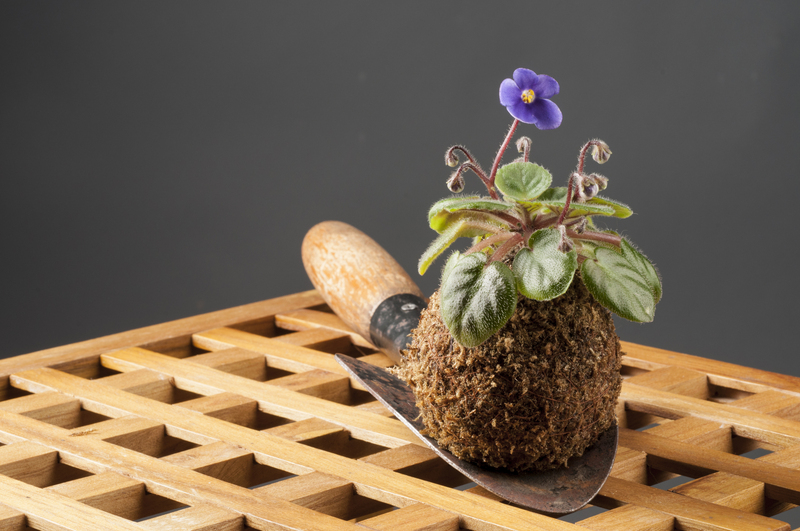Unlock the Secrets to a Bountiful Herb Garden
Posted on 24/05/2025
Unlock the Secrets to a Bountiful Herb Garden
Imagine stepping outside your door to pluck a handful of fresh basil, thyme, or mint for your evening meal. Creating a lush and productive herb garden is easier than you think--if you know the secrets! Growing a bountiful herb garden not only adds beauty and fragrance to your space but ensures a steady supply of flavorful and nutritious greens all year round. Whether you're a seasoned gardener or a beginner, this comprehensive guide will help you unlock the secrets to a thriving herb oasis.

Why Grow an Abundant Herb Garden?
Herb gardens offer myriad benefits beyond just flavoring your food. Here's why you should start your own today:
- Easy to Grow: Many herbs are hardy and require minimal maintenance.
- Cost Savings: Store-bought herbs can be expensive. Growing your own cuts grocery costs.
- Freshness and Flavor: Herbs lose flavor after harvesting--homegrown herbs are always fresh and potent.
- Health Benefits: Herbs are rich in vitamins, minerals, and antioxidants.
- Pollinator Friendly: Many herbs attract bees and butterflies, supporting your local ecosystem.
Understanding the Basics: What Makes an Herb Garden Bountiful?
Unlocking the secrets to a thriving herb garden starts with understanding the key factors that determine plant health and productivity. A bountiful garden isn't just about planting seeds--it's about creating the perfect environment for your herbs to flourish.
1. Choosing the Right Location
Most herbs require at least 6-8 hours of sunlight daily. Select a spot that gets full sun, preferably with some protection from harsh afternoon rays. Watch for areas that may have standing water after rain, as herbs generally dislike soggy roots.
- South or west-facing locations are ideal for sun-loving herbs.
- Ensure good air circulation to reduce the risk of fungal diseases.
- Consider raised beds, containers, or window boxes for flexibility.
2. Perfecting Your Soil Mix
A common mistake in herb gardening is neglecting the soil. Most herbs prefer well-drained, slightly alkaline soils with a pH of 6.0-7.5. Sandy or loamy soils tend to be best.
- Work in organic matter like well-rotted compost or aged manure.
- If drainage is poor, use raised beds or mix in coarse sand or perlite.
- Test your soil and adjust the pH if necessary with lime (to raise) or sulfur (to lower).
3. Selecting the Best Herbs for Your Garden
The secret to continuous abundance is growing herbs suited to your conditions and needs. Start with the basics and expand to more exotic or medicinal herbs as you gain confidence.
- Basil: Loves heat and sunshine, perfect for summer gardens.
- Parsley: Biennial, thrives in cooler weather, rich in vitamin K.
- Thyme: Drought-resistant, grows well even in rocky soil.
- Mint: Vigorous and can be invasive; best in containers.
- Rosemary: Evergreen, prefers sandy soil and full sun.
- Cilantro: Fast-growing but bolts in heat; succession sow for continuous harvests.
- Dill, Oregano, Sage, Chives, and more: Easy to grow and invaluable in the kitchen.
Secrets to Starting Your Herb Garden: From Seed or Transplant?
Deciding whether to start herbs from seeds or small plants depends on your experience and the variety you choose. Here's how to unlock the secret behind each method:
Growing Herbs from Seed: Tips for Success
- Read Packets Carefully: Some herbs (like basil and dill) are easy from seed; others (like rosemary) germinate slowly.
- Early Start Indoors: Start seeds 6-8 weeks before the last frost for a head start.
- Direct Sow: Cold-hardy herbs like parsley and cilantro can be planted right into cool early spring soil.
- Light Requirement: Use a sunny windowsill or grow lights for strong seedlings.
- Thin Seedlings: Overcrowding reduces vigor. Thin to recommended spacing.
Transplanting Nursery Starts
- Convenience: Perfect for beginners--gives instant gratification and quick harvests.
- Acclimate: Harden off young plants before moving outdoors to avoid shock.
- Spacing: Allow enough space for mature growth. Overcrowded herbs compete for water and nutrients.
Many gardeners use a combination of both methods--starting easy-to-germinate herbs from seed and buying nursery transplants for tricky ones.
Unlocking the Art of Herb Garden Design
Strategic design is a secret weapon for a plentiful herb harvest. Whether you have a patio, balcony, or acres, you can create a productive and beautiful space.
Raised Beds vs. Containers vs. In-Ground Gardens
- Raised Beds: Superior control over soil quality and drainage--great for most herbs.
- Containers: Versatile and mobile; perfect for mint and herbs that require different watering needs.
- In-Ground Beds: Cost-effective for larger gardens; use for perennial herbs like sage, thyme, and oregano.
Creative Herb Garden Ideas
- Vertical Herb Gardens: Utilize walls or fences with pocket planters for small spaces.
- Spiral Herb Gardens: Create a mound with spiraling stones for compact, visually appealing growth and varied microclimates.
- Kitchen Windowsills: Grow basil, chives, or coriander close at hand for cooking inspiration.
How to Keep Your Herb Garden Healthy and Bountiful
Regular maintenance is key to unlocking ongoing abundance. Even the sturdiest herbs benefit from a little TLC.
Watering Wisely
- Most herbs prefer soil that dries out slightly between waterings.
- Overwatering can cause root rot, especially in containers. Stick your finger in the soil--if it's dry to an inch deep, it's time to water.
- Water early in the day to minimize evaporation and reduce risk of disease.
Smart Fertilizing
- Too much fertilizer produces lush growth but can dilute flavor. Aim for a light feeding every 4-6 weeks.
- Use balanced organic fertilizers or aged compost.
Pruning and Harvesting
- Pinch back herbs regularly to encourage bushy growth.
- Harvest often but never remove more than a third of the plant at once.
- Prune flowering stems from culinary herbs (like basil and parsley) to keep leaves tender and flavorful.
Pest and Disease Management
- Grow healthy plants--stressed herbs are more susceptible to pests.
- Encourage beneficial insects by mixing flowers, like calendula or nasturtium, into your beds.
- Handpick pests or use organic controls if needed. Avoid sprays--herbs are meant to be eaten!
Winter Protection
- Perennials like thyme, chives, and sage survive mild winters. Mulch heavily to insulate roots.
- Bring tender herbs like basil and rosemary indoors or grow them in pots over winter.
Harvesting and Storing Herbs for Lasting Abundance
Unlocking the full potential of your thriving herb garden means preserving herbs for later use.
Best Harvesting Practices
- Pick in the morning, after dew dries but before sun wilts leaves, for peak flavor and aroma.
- Use sharp scissors or garden shears to avoid bruising stems.
- Wash gently and dry thoroughly before storage.
Drying and Freezing Herbs
- Drying: Tie small bundles together and hang in a cool, shaded spot. Store dried leaves whole in airtight containers and crush as needed.
- Freezing: Chop fresh herbs and freeze in ice cube trays with a bit of water or oil. Perfect for soup and stew season!
Troubleshooting Common Herb Garden Problems
Even the most experienced gardeners face challenges. Here are a few secrets for overcoming common herb gardening pitfalls:
- Yellowing leaves: Often caused by overwatering or poor drainage. Check soil and reduce watering.
- Leggy growth: Insufficient sunlight. Move to a sunnier spot and pinch back stems.
- Poor germination: Seed depth or temperature issues--follow guidelines for each herb and use fresh seeds.
- Insect infestations: Try spraying with a mild solution of water and dish soap, or introduce beneficial insects.
- Bolting: Cool-weather herbs like cilantro, parsley, or dill may flower and go to seed in hot weather--sow successively for a steady supply.
Beyond the Basics: Secrets to an Extraordinary Herb Garden
Once you've mastered the basics, experiment with these advanced tips to create a truly bountiful herb oasis:
-
Companion Planting:
- Grow basil with tomatoes for enhanced flavor and pest-repellent properties.
- Chives and garlic ward off aphids from roses and carrots.
-
Successive Planting:
- Stagger sowings of short-lived herbs like cilantro and basil for continual fresh harvests.
-
Growing Lesser-Known Herbs:
- Try lemon balm, lovage, savory, or shiso to diversify flavors and health benefits.
-
Natural Mulching:
- Use straw or shredded leaves to retain moisture, inhibit weeds, and feed your soil.
-
Herb Garden Decor:
- Wind chimes, stepping stones, or artistic plant markers add charm and personal flair.

Seasonal Care for Year-Round Bounty
To keep your herb garden flourishing in all seasons, adapt your care routine throughout the year.
Spring
- Start new seeds, transplant seedlings, and refresh garden beds with compost.
- Prune established perennials to encourage fresh growth.
Summer
- Harvest regularly to keep plants producing and prevent bolting.
- Watch for pests and water deeply during dry spells.
Fall
- Sow cool-weather herbs and bring tender plants indoors as temperatures drop.
- Dry or freeze surplus for winter use.
Winter
- Protect perennials with mulch. Grow windowsill herbs indoors for fresh greens all winter.
- Plan next year's garden and order seeds early.
Unlock Your Own Secret: Start a Bountiful Herb Garden Today!
Unlocking the secrets to a bountiful herb garden is about more than just gardening--it's about cultivating a connection to nature, improving your culinary creations, and supporting a sustainable lifestyle. Anyone, from city apartment dwellers to country homeowners, can grow an abundant herb garden with a little knowledge, some attention, and plenty of passion. Embrace these tips, experiment with your favorites, and enjoy the aroma, beauty, and endless flavor of your very own thriving herb oasis.
Ready to get started? Unlock the full potential of your outdoor (or indoor) space and savor the bounty of homegrown herbs every day!

